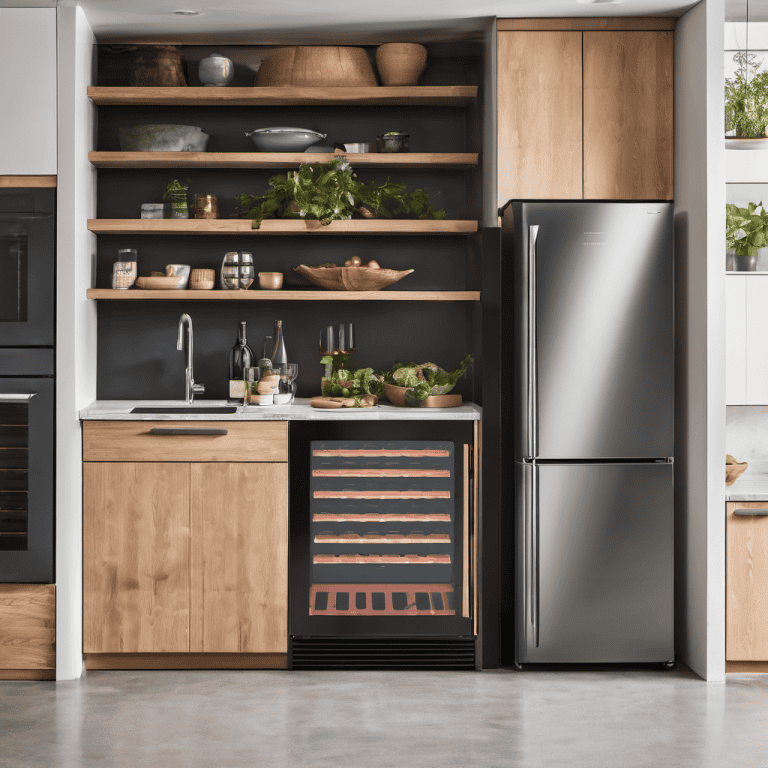Did you know that fine wine consumption in urban areas has increased by 35% in the last decade? Yet, many city dwellers face a common challenge: limited space for proper wine storage.
Wine locker storage has emerged as a solution for urban wine enthusiasts, offering professional storage conditions without the need for a personal cellar. But is this storage option right for you?
Let’s explore the “Pros and Cons” of wine locker storage to help you make an informed decision.
Welcome to Didi Somm and Cheers!
Important Notice: The information in this article is for general and public information purposes only. It solely reflects Didi Somm’s or his Staff’s opinion, and no responsibility can be assumed for errors or omissions in the service’s contents. For details, please check the Disclaimer at the bottom of the homepage.

Key Takeaways
- Wine lockers provide temperature-controlled environments essential for proper wine aging
- Professional facilities offer enhanced security and insurance options
- Costs vary based on location and locker size, typically ranging from $50-500 monthly
- Access options and terms differ among facilities
- Most locations offer additional services like inventory management and shipping
Understanding Wine Locker Storage Systems
Let me tell you about my first encounter with a wine locker system – it was like discovering a high-tech sanctuary for wine! After years of struggling with my apartment’s inconsistent temperatures, I finally explored professional wine storage.
Wine lockers are essentially your personal mini-cellar within a larger facility, ranging from simple wire cages to elegant wooden lockers. The most common setup I’ve seen includes individual lockers arranged in temperature-controlled rooms, typically featuring double-redundant cooling systems to maintain that perfect 55°F (13°C).
These facilities are getting pretty sophisticated these days – the one I use has biometric security, 24/7 surveillance, and backup generators. What really impressed me was the humidity control system maintaining a steady 70% humidity level.
Some facilities even offer different temperature zones for various wine styles, though I stick with the standard storage conditions for my collection.

Benefits of Wine Locker Storage
After storing my wines at home for years (and losing a few precious bottles to heat damage), switching to a professional wine locker was a game-changer!
Consistent Temperature And Humidity
The most obvious benefit is the perfect storage environment – consistent temperature and humidity that my home setup could never achieve.
Insurance Coverage
But here’s what really sold me: The insurance coverage. My facility offers comprehensive insurance that covers everything from theft to environmental damage. (Pro Tip: Carefully read the Terms & Conditions when checking a particular offer).
Professional Handling
The professional handling has been incredible, too – they track every bottle with a sophisticated inventory system, and I can check my collection through their app anytime.
The Community
One unexpected perk? The community! I’ve met some amazing fellow collectors during the facility’s monthly tastings, and we often share tips and recommendations. These connections have led to some fantastic wine discoveries and even a few trades.
Potential Drawbacks to Consider
Access Hours
I’ve got to be honest – wine locker storage isn’t all roses and perfect Bordeaux. The biggest hurdle for me was adjusting to the access hours. No more midnight runs to grab that perfect bottle for an impromptu dinner party! My facility closes at 8 PM, which has required some advance planning.
Costs
The costs can add up too – beyond the monthly rental fee (which varies by location and locker size), there are handling fees for frequent access and additional charges for services like inventory management.
Location & Minium Storage Duration
Location has been another challenge – the nearest facility is 30 minutes from my home, which means I need to plan my visits carefully. Plus, most facilities require at least a 6-month commitment, so you need to be sure about your storage needs before signing up.
Cost Analysis of Wine Locker Storage
Let’s talk numbers – and believe me, I’ve done my homework on this! In major urban areas like New York or San Francisco, expect to pay anywhere from $150-500 monthly for a standard locker holding 50-200 bottles.
Pricing
The pricing usually follows a tiered system:
- Small Lockers (up to 50 bottles) start around $50-100 monthly
- Medium Lockers (100-200 bottles) range from $150-300 monthly
- Large Lockers (over 200 bottles) can exceed $500 monthly
Insurance Costs
Insurance costs typically run 1-2% of your collection’s value annually. Some facilities offer discounts for annual commitments – I saved 15% by paying upfront for a year.
Extra Fees
Watch out for those extra fees, though – handling charges, inventory management, and shipping services can add 20-30% to your base rental cost.
How to Choose the Right Wine Storage Facility
Finding the right wine storage facility was quite the journey, and I learned some valuable lessons along the way!
Location
Start with location – I initially chose a facility 45 minutes away because of lower prices, but quickly realized the inconvenience wasn’t worth the savings.
Security
Security features are non-negotiable – look for facilities with 24/7 video surveillance, individual lock systems, and controlled access.
Temperature Monitoring
Temperature monitoring is crucial – ask to see their temperature logs and backup systems.
Consistency
I always recommend visiting during different times of day to check consistency. The facility I chose provides real-time temperature and humidity monitoring through their app, which gives me great peace of mind.
Access Policies
Don’t forget to review their access policies thoroughly – some facilities require advance notice for visits, while others offer unlimited access during business hours.

Pro Tip: To check the actual services of companies in this industry, we recommend checking the following websites: UOVO Wine, The Lock Up, or America’s Top Wine Storage Facilities (an article published by The Chicago Wine & Sommelier School).
Setting Up Your Wine Locker
Setting up my wine locker was both exciting and nerve-wracking!
First things first – you’ll need to complete quite a bit of paperwork, including identification, insurance forms, and a detailed rental agreement. Most facilities require an inventory of your initial collection, which actually helped me organize everything better.
When moving my wines, I learned the hard way to use proper wine boxes with dividers – those flimsy cardboard boxes from the wine shop just don’t cut it! I’ve developed a system using bin locations and tags that makes tracking my collection much easier. Essential supplies I recommend include a wine log (digital or physical), handling gloves, and proper packing materials.
The facility’s inventory management system has been a lifesaver, but I still maintain my own spreadsheet as a backup.
Pro Tip: Take photos of all your bottles before storage – it’s saved me countless times when trying to locate specific wines!
FAQ – Wine Locker Storage
- Q: What is the average cost of a wine locker? A: Wine locker costs typically range from $50-500 monthly, depending on size and location.
- Q: Are wine lockers temperature-controlled? A: Yes, professional wine lockers maintain consistent temperatures between 55-57°F (13-14°C).
- Q: How often can I access my wine locker? A: Access policies vary by facility, but most offer daily access during business hours.
- Q: What security measures are typically in place? A: Facilities usually have 24/7 surveillance, biometric access, and individual lock systems.
- Q: Do I need insurance for my wine collection? A: While facilities offer basic insurance, additional coverage is recommended for valuable collections.
- Q: What sizes are available for wine lockers? A: Sizes typically range from 12-bottle lockers to full-room storage capable of holding thousands of bottles.
- Q: Can I store other items in my wine locker? A: Most facilities restrict storage to wine and wine-related items only.
- Q: How long is the minimum rental period? A: Minimum terms usually range from 3-12 months, depending on the facility.
- Q: Are there climate control backup systems? A: Professional facilities maintain backup generators and redundant cooling systems.
- Q: Can someone else access my wine locker? A: You can authorize additional users, but they must be registered with the facility.
- Q: What happens if there’s a power outage? A: Facilities have backup power systems to maintain proper storage conditions.
- Q: Are there wine tasting areas available? A: Many premium facilities offer tasting rooms and event spaces.
- Q: How is inventory tracked? A: Most facilities offer digital inventory management systems and regular updates.
- Q: Can the facility ship wine to me? A: Many facilities offer shipping services for an additional fee.
- Q: What documentation is needed to rent a wine locker? A: Typically, ID, proof of address, and signed rental agreement are required.
Conclusion
Wine locker storage presents a viable solution for urban wine collectors, offering professional-grade storage conditions and security. While costs and access limitations should be carefully considered, the benefits of proper wine storage and preservation often outweigh the drawbacks for serious collectors.
Whether you’re just starting your collection or need to expand your storage options, wine lockers provide a sophisticated solution for urban wine enthusiasts.
Ready to explore wine locker options in your area? Contact local facilities to schedule tours and compare services to find the perfect fit for your collection.
Good luck and Cheers!
For your reference, the latest articles by Didi Somm include:
- Compact Wine Racks: Expert Advice On Best Use Of Space
- DIY Wine Carriers: 7 Creative Ideas That Surprise You
- Most Durable Wine Travel Accessories – Best Expert Guide For You
- Guide to Commercial Wine Storage: Best Expert Insights
- Retail Wine Storage Solutions: Best Expert Advice
- Commercial Wine Cellar Organization – Best Expert Guide
Important Notice: The information in this article is for general and public information purposes only. It solely reflects Didi Somm’s or his Staff’s opinion, and no responsibility can be assumed for errors or omissions in the service’s contents. For details, please check the Disclaimer at the bottom of the homepage.



